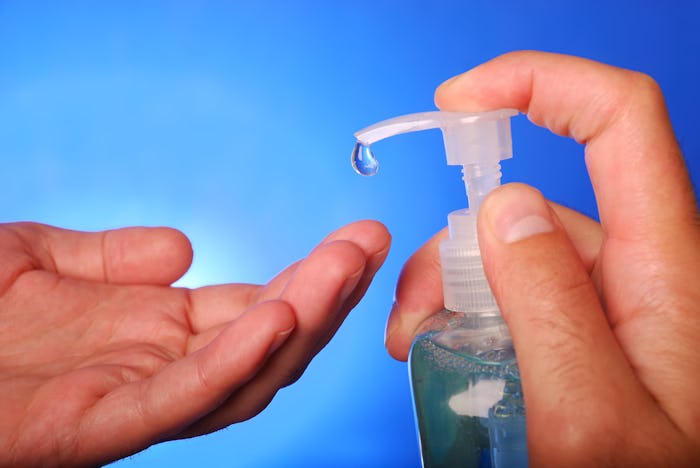News

No, Hand Sanitizer Is Not The Most Effective Way To Help Prevent Norovirus
Since January 2020, data from the U.S. Centers for Disease Control and Prevention (CDC) shows there have been over 500 norovirus outbreaks in the United States in the 2019-2020 season. With contagious viruses, parents of course want to know how to best protect their children — and using hand sanitizer on a regular basis may seem like a practical solution. But in reality, can hand sanitizer actually kill norovirus?
The short answer? No, it's not as effective as you may have thought.
"Alcohol-based hand disinfectant, though effective against a number of viruses and bacteria that cause gastroenteritis, is not in and of itself effective in reducing the transmission of norovirus," Dr. Trong Tony Trinh, M.D., an infectious disease physician at the Polyclinic in Seattle, Washington, tells Romper.
Trinh says that hand-washing is the best way to prevent the spread of norovirus as well as "contact precautions, environmental cleaning, and isolation" from patients who have the virus. "Individuals with norovirus infection should not prepare food for others for at least two days after resolution of symptoms," according to Trinh, while children should be kept out of child care centers until their stools are "no more than two" more frequent in comparison to what they would normally be.
Norovirus, which is not related to the flu, is a highly infectious disease that causes gastrointestinal issues like vomiting and diarrhea, according to the National Foundation for Infectious Diseases. It can be passed through contaminated food, contact with an infected person, or by touching surfaces where pathogens might be present and subsequently putting unwashed hands in your mouth. According to the CDC, outbreaks typically tend to be more common between November and April and happen in places like daycare centers, schools, restaurants, hospitals, and cruise ships.
Confusion surrounding whether or not hand sanitizer could kill norovirus may be attributed to companies making marketing claims that it essentially could. In 2018, the U.S. Food and Drug Administration (FDA) filed a complaint against Innovative BioDefense Inc., the makers of Zylast hand sanitizers, for making claims that its products were "effective against infection by pathogens such as norovirus, rotavirus, flu virus, Methicillin-Resistant Staphylococcus Aureus (MRSA), and Ebola."
In 2013, Innovative BioDefense said in a press release, citing a study, that "Zylast has proven it can effectively kill the norovirus immediately." According to the FDA, this claim was highly misleading. "Claims that a hand sanitizer can protect consumers against infection from pathogens are drug claims and therefore, these products are regulated by the FDA as drugs," the FDA said in 2018. "These products from Innovative BioDefense, Inc. have not been proven to be safe and effective for these uses and are not approved by the FDA."
In January 2020, the FDA sent a similiar warning letter to GOJO Industries, makers of Purell hand sanitizer, for marketing its products with claims that imply they could be used to kill viruses and prevent disease. Purell's website has since been updated.
With all that said, while proper hand hygiene is the best way to protect your family from contracting norovirus, if soap and water are not available at the moment, using a hand sanitizer with at least 60% alcohol can be used in a pinch. The CDC stresses that hand sanitizer should not be used as a substitute for hand-washing; rather it can be used in addition to soap and water. So, in order to keep yourself and your family healthy, remember to wash your hands with soap and warm water often, especially when handling food or after using the bathroom, and if you do feel sick, stay home from work or school and avoid food preparation altogether.
Editor's Note: This article has been updated to reflect the most recent guidance from the FDA.
Expert referenced:
Dr. Trong Tony Trinh, M.D., MPH, infectious disease physician at the Polyclinic in Seattle, Washington.
This article was originally published on